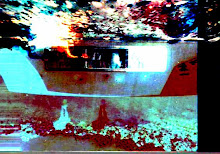Neon Panopticon is a sorta mini-LP or a longer EP...it lies somewhere between an EP and LP in length, at least in terms of my albums, which can be admittedly a bit on the long side at times. While the word "panopticon" was appealing because "icon" can be found at the end of it, the interest in the word extended beyond mere graphic possibilities. It is partially inspired by a recent personal experience with law authority but also by the concept of the "panopticon" as developed in the late 18th century by Jeremy Bentham. For those unfamiliar, Bentham's concept basically describes a specifically designed prison in which an ominous guard tower sits atop and at the center of the circular structure with the rest of the prison and all the cells built into the surrounding circle. The key idea being that from this guard tower at the institution's core the guards can observe anything and everything from their position while the inmates are unable to see the jailers in the high tower and will hopefully behave themselves never knowing for sure if they're being watched. More importantly, the key ideas of the panopticon were later adopted by French philosopher Michel Foucault who applied them to his theories on social conformity and power structures. I was also thinking about the idea of "death" or "suicide" by cop while recording this album; to purposely end one's own life through an aggressive (although sometimes hardly threatening at all) manner of endangering a cop's (or multiple cops) life. Often, this is the ultimate escape route taken out of desperation because of an extreme situation, which is perhaps more often the case than someone simply planning suicide and seeking out police to execute (pun intended!) the plan.
And so, the album is kind of a loose conceptual piece about these aspects of social authority, conformity and structures with the first (and titular) track being a sprawling 20 minute long epic about the panopticon in a sense, structured somewhat in a circular style with the opening 4 minutes of a more "traditional" nature, resembling a post-punk type of track (sort of like the more uplifting Joy Division songs or the earlier ones by New Order). That opening movement gives way to the bulk of the track, a heavily atmospheric middle section in which thick slabs of drone are layered over each other, smothered in reverb and disoriented loops, haunted by cavernous vocals with moaning calls and hypnotic chants. The song circle is "closed" following the psychedelic cacophony of this middle section as a motorik beat-infused song slowly builds out of the ambiance, propelling forwards and upwards with a driving rhythm that eventually climaxes into a rather joyfully grandiose finale. The intention was to reinforce this loosely circular concept by not only the bookend movements but also the melody similarity shared predominantly between these two movements, as well as in a much more subtle manner throughout the middle section.
The second, and shortest at less than 5 minutes, track is perhaps the least conceptually-relevant song but I liked the double entendre quality of the title that is hopefully obvious. Sonically, I feel it is a kindred spirit with the first and last movements of the opening track; as it is, like those sections, driven by a bouncy krautrock style beat, and then accompanied by a fairly bittersweet melody on the bass guitar and guitars, which is then emphasized by some glockenspiel and melodica. The last track is a massive beast of relentless bass throb and break-beat-esque drums that are fairly repetitive for most of the 15+ minutes, although with some nuanced changes. Spread over the restless rhythm section are echoing guitars, vocal loops, a wailing slide guitar, drones, and other nigh-unrecognizable psychedelic sounds. Perhaps it goes without saying for some but the dominating influence over this song is Can's "Halleluhwah" the mammoth centerpiece on their masterpiece Tago Mago (1971), as well as "Oh Yeah" to a slightly lesser extent.
DOWNLOAD:
NEON PANOPTICON
